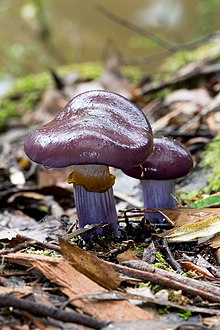
Cortinarius austrovenetus, alternately known as Dermocybe austroveneta and commonly known as the green skin-head but also known as green dermocybe is an inedible brightly coloured green gilled fungus that naturally occurs in south eastern Australia.

Cortinarius mucosus, commonly known as the orange webcap or the slimy cortinarius, is a species of mushroom in the family Cortinariaceae. In North America, the species is more commonly associated with northern coniferous forests. The specific epithet is derived from the Latin word mucosus, meaning mucus.

Phlegmacium triumphans, also known as the birch webcap, or yellow girdled webcap is a basidiomycete mushroom in the family Cortinariaceae. It is found in Europe and regarded as edible by some authorities, although others call it suspect and it resembles inedible species.

Cortinarius rotundisporus, also known as the elegant blue webcap, is a basidiomycete mushroom of the genus Cortinarius found in southern Australia, where it is found in eucalypt forests and rainforests. The cap of the fruit body is a steely blue colour, with a yellowish boss, and paler similarly coloured stipe.

Cortinarius violaceus, commonly known as the violet webcap or violet cort, is a fungus in the webcap genus Cortinarius native across the Northern Hemisphere. The fruit bodies are dark purple mushrooms with caps up to 15 cm (6 in) across, sporting gills underneath. The stalk measures 6 to 12 centimetres by 1 to 2 cm, sometimes with a thicker base. The dark flesh has a smell reminiscent of cedar wood. Forming symbiotic (ectomycorrhizal) relationships with the roots of various plant species, C. violaceus is found predominantly in conifer forests in North America and deciduous forests in Europe.
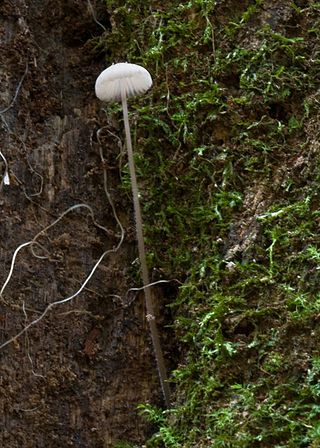
Mycena cystidiosa is a species of mushroom in the family Mycenaceae. Described as new to science in 1964, it is known only from New Zealand and Australia. The fruit bodies have a broadly conical small white cap up to 12 mm (0.5 in) wide, with distantly spaced cream-coloured gills on the underside. The stipe is particularly long, up to 20 cm (8 in), with an abundant covering of white hairs at the base. The species is known for its abundant rhizomorphs—long, root-like extensions of mycelia.

Meinhard Michael Moser was an Austrian mycologist. His work principally concerned the taxonomy, chemistry, and toxicity of the gilled mushrooms (Agaricales), especially those of the genus Cortinarius, and the ecology of ectomycorrhizal relationships. His contributions to the Kleine Kryptogamenflora von Mitteleuropa series of mycological guidebooks were well regarded and widely used. In particular, his 1953 Blätter- und Bauchpilze [The Gilled and Gasteroid Fungi ], which became known as simply "Moser", saw several editions in both the original German and in translation. Other important works included a 1960 monograph on the genus Phlegmacium and a 1975 study of members of Cortinarius, Dermocybe, and Stephanopus in South America, co-authored with the mycologist Egon Horak.
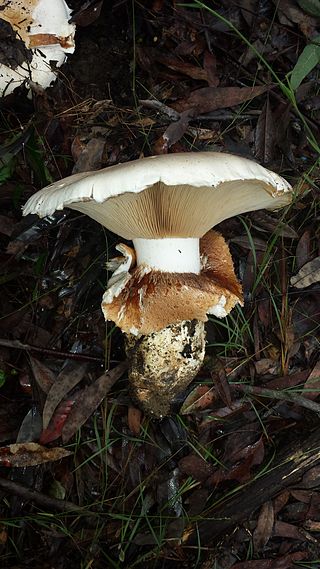
Austrocortinarius australiensis, commonly known as the skirt webcap, is a species of mushroom in the family Cortinariaceae which is native to Australia and New Zealand. The white mushrooms appear in autumn and can grow very large, with their caps reaching 30 cm (12 in) in diameter.

Phlegmacium cruentipellis is a rare species of agaric fungus in the family Cortinariaceae.
Calonarius flavipallens is a species of agaric fungus in the family Cortinariaceae.
Phlegmacium subfraudulosum is a species of mushroom producing fungus in the family Cortinariaceae. It was previously known as Cortinarius subfraudulosus.
Phlegmacium boreicyanites is a species of fungus in the family Cortinariaceae
Phlegmacium caesiocolor is a species of fungus in the family Cortinariaceae.
Phlegmacium cremeiamarescens is a species of fungus in the family Cortinariaceae. It was originally described in 2014 by the mycologists Ilkka Kytövuori, Kare Liimatainen and Tuula Niskanen who classified it as Cortinarius cremeiamarescens. It was placed in the of the large mushroom genus Cortinarius. The specific epithet cremeiamarescens refers to the fruitbody colour and the bitter-tasting cap cuticle. Phlegmacium gentianeus is a sister species with which it has been previously confused. It is found in southern Europe and western North America, where it grows in coniferous forests.

Cortinarius erythraeus, sometimes known as the Jammie Dodger, is a basidiomycete fungus of the genus Cortinarius native to Australia.

Cortinarius cyanites is a basidiomycete fungus of the genus Cortinarius native to Europe.
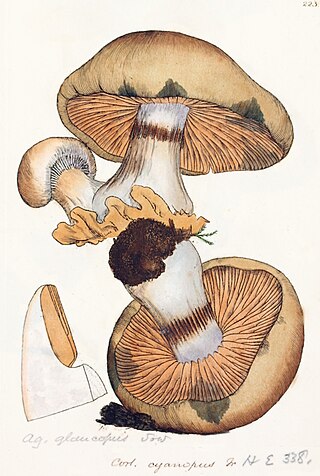
Phlegmacium glaucopus is a species of fungus in the family Cortinariaceae. It is commonly known as the blue-foot webcap.
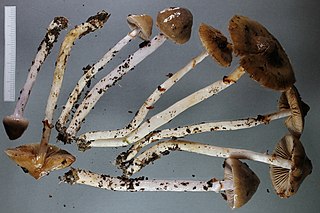
Cortinarius cucumeris is a basidiomycete fungus of the genus Cortinarius native to New Zealand, where it grows under Nothofagus.

Cortinarius sublargus is a species of fungus in the family Cortinariaceae native to Australia. It was described in 1928 by John Burton Cleland from the Mount Lofty Ranges. Cleland also described Cortinarius radicatus in 1933 from material collected in Willunga Hill, Waitpinga, Mount Lofty, Mount Compass, and Kinchina, Though Cleland regarded them as distinct, later authorities determined them to be the same species. The latter name turned out to be a homonym, having already been given to a different species.

Thaxterogaster austrovaginatus is a species of ectomycorrhizal fungus in the famlily Cortinariaceae.
